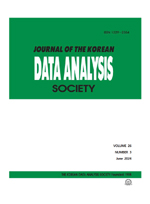상장지수펀드의 성과에 영향을 미치는 상장지수펀드의 횡단면 특성
Cross-sectional characteristics of ETFs that affect performance of ETFs
- 한국자료분석학회
- Journal of The Korean Data Analysis Society (JKDAS)
- Vol.26 No.4
-
2024.081121 - 1139 (19 pages)
-
DOI : 10.37727/jkdas.2024.26.4.1121
- 이용수 26

키워드
초록
본 연구는 상장지수펀드의 횡단면 특성이 상장지수펀드의 장기 수익률이 어떤 영향을 주는지 연구하였다. 횡단면 특성으로 추적 배수, 기초시장분류, 과세유형, 운용사, 기초지수, 변동성, 복제 방법, 분류체계, 지수산출기관, 기초자산분류를 이용하였으며, 이 특성들은 모두 명목변수의 특징을 가지고 있다. 상장지수펀드의 성과로 적립식 수익률과 거치식 수익률, 수익률 차이(=적립식수익률 - 거치식수익률)을 이용하였다. 추적 배수는 1X인버스, 2X레버리지, 2X인버스, 일반의 범주가 있고, 기초시장분류는 국내, 국내 & 해외, 해외의 범주가 있다. 추적 배수와 기초시장분류는 모두 적립식 수익률, 거치식 수익률, 수익률 차이에 횡단면 영향을 미쳤다. 과세유형은 비과세인 경우에만 유의하게 적립식 수익률, 거치식 수익률에 횡단면으로 영향을 미쳤다. 배당소득세(분리 과세 부동산 ETF)는 종속변수가 적립식 수익률인 경우에만 영향을 미쳤다. 과세유형이 배당소득세(해외 주식 투자 전용 ETF)인 경우는 적립식 수익률과 거치식 수익률에 영향을 미치지 않았다. 상장지수펀드의 횡단면 특성에 따라 상장지수펀드의 성과에 차이가 나고 있음을 발견한 점은 본 연구의 기여도가 된다.
This study investigates how cross-sectional characteristics of ETFs affect the long-term returns of ETFs. We use tracking multiples, underlying market classification, tax type, manager, underlying index, volatility, replication method, classification system, index producer, and underlying asset class as cross-sectional characteristics, all of which are characterized by nominal variables. The performance of ETFs is characterized by Dollar Cost Averaging (DCA) returns, Lump-sum deposit (LD) returns, and return differential (RD=DCA-LD). Tracking multiples are categorized into 1X Inverse, 2X Leveraged, 2X Inverse, and Normal, and underlying market classifications are categorized into Domestic, Domestic & International, and International. Both tracking multiples and underlying market categorization had a cross-sectional impact on DCA returns, LD returns, and RD. Taxation type had a significant cross-sectional effect on DCA and LD returns only for non-taxable. Dividend income tax (separately taxed real estate ETFs) had an impact only when the dependent variable was DCA returns. Dividend income tax (foreign equity only ETFs) had no effect on DCA and LD returns.
목차
1. 서론
2. 연구 자료 및 연구 모형
3. 연구 결과
4. 결론
References
참고문헌 (0)
등록된 참고문헌 정보가 없습니다.
해당 권호 수록 논문 (0)
등록된 수록 논문 정보가 없습니다.